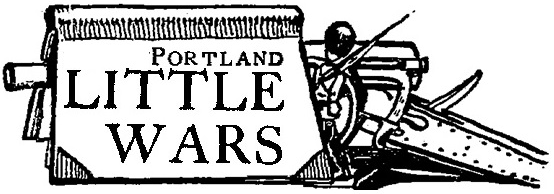The Britons were defending and began the game in a long battle line to the "south". The Saxons (with their usual Irish allies/mercenaries) were coming on the board from the "north". The Saxons would score victory conditions by trying to get as many units as possible across either the ford (some sand on the river near the center of the table) or the bridge located to the "east".
(Above: starting positions)
(Above: starting positions)
The rest of the Saxon army (played by me) was able to come on board fairly quickly. The Britons (Jamie again) advanced their lines and formed up on one bank of the river. The Saxons also formed a line and advanced forward cautiously. I initially considered attempting a general forward advance by the entire Saxon line, getting in range where my javelins could perhaps create a weak point that I could exploit, and I formed the Saxon battle line with this in mind. However, at the last second I lost confidence and just blundered about half of the Saxon forces at each of the crossings.
(Crossing at the ford is attempted)
I screwed up by not wanting to move at half-rate across the river, and instead tried to funnel Saxon infantry across the ford. The Briton shieldwall of course held so an immediate bottleneck was created. I should also have sent both Irish units at the ford since they are classed as fleet footed so could have dashed across the river created some chaos with their ferocious charge one-time melee bonus (reroll all misses).
(Above: Briton cavalry counterattacking the ford)
Instead I sort of muddled around the crossing, and the Britons used archery and some cavalry counter-attacks to chase off the assault.
(Above: Saxon right in disarray, nowhere near the ford. At top, Saxon assault n the bridge has gone nowhere with massive casualties)
With the effort on the right flank a complete go-nowhere, the fresh units on the Saxon left attempted to force the bridge. This was met with even less success as the Briton shieldwall held and Briton cavalry and archers again dispersed other attempts to cross the river itself.
While this game and the prior two have been pretty one-sided defeats for the Saxons, they were still fun games and had their touch-and-go moments. The obvious fixes needed is that Briton archery is too strong, range might need to be reduced to 12" instead of 18", and the Shieldwall rule should probably be +1 Armor vs. shooting and melee rather than -1 To Hit, which probability-wise make the Shieldwall practically invincible. The armor rating for the majority of infantry might also need to be upgraded to 3 instead of 2 in order to get a little more of a back-and-forth in melee, preferably taking a few rounds before one side breaks. As currently written, units are loosing 4-6 casualties right off the bat, which is fast but perhaps too extreme.
Jamie had so much fun he went out and bought a Pictish army from Old Glory, in response to which I have started painting my late legionaries to bulk up the Britons some more. More games in the Barbarian West forthcoming, no doubt!












